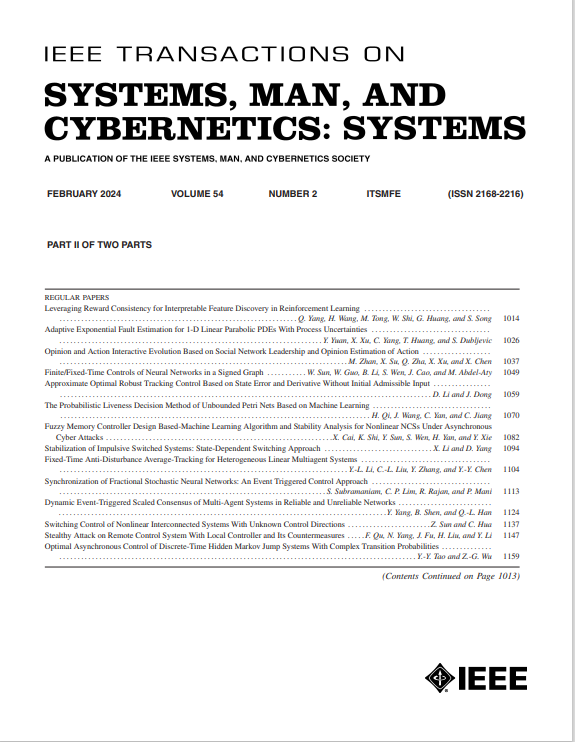Predictive Path Coordination of Collaborative Transportation Multirobot System in a Smart Factory
IF 8.6
1区 计算机科学
Q1 AUTOMATION & CONTROL SYSTEMS
IEEE Transactions on Systems Man Cybernetics-Systems
Pub Date : 2024-08-06
DOI:10.1109/TSMC.2024.3431222
引用次数: 0
Abstract
Smart factories employ intelligent transportaton systems such as autonomous mobile robots (AMRs) to support real-time adjusted production flows for agile and flexible production. While decentralized transportation task execution provides a scalable multirobot system (MRS) for a smart factory, new coordination challenges arise in implementing such a system. Transportation-MRS collaborates with production-MRS to accommodate just-in-time (JIT) production, leading to nonstationary transportation tasks that transportation-MRS must learn and adapt to. Also, decentralized operation on a shared shop floor means that one robot cannot factor in peer robots’ task execution planning, leading to competitive collisions. Meanwhile, predictive coordination with communication among multiple learning and adapting intelligent robots is still an open problem. On top of identifying the aforementioned challenges, this article first proposes a multifloor transportation graph model to discretize transportation task execution and allow real-time adjustment of transportation paths toward collision-free. We introduce a unique collaborative multi-intelligent robot system approach taking each robot as a cyber–physical agent with automated artificial intelligence (AI) workflow. First, it includes a novel multiagent reinforcement learning (MARL) algorithm, where each robot predictively plans collision-avoidant paths. Second, we introduce a token-passing mechanism to resolve inevitable competitive collisions due to nonstationary tasks. The proposed approach innovatively uses the multifloor model as a domain model for planning. By allowing competitive collision to occur and resolve, a robot only needs to learn and adapt to uncertain parts of the environment—nonstationary tasks and peer robots’ paths. Computational experiments show that our approach is both sample-efficient and computationally efficient. The transportation-MRS quickly reaches near-optimal performance levels, which are empirically shown to scale with the number of robots involved.智能工厂中协作运输多机器人系统的预测路径协调
智能工厂采用自主移动机器人(AMR)等智能运输系统,支持实时调整生产流程,以实现灵活敏捷的生产。虽然分散式运输任务执行为智能工厂提供了一个可扩展的多机器人系统(MRS),但在实施这样一个系统的过程中也出现了新的协调挑战。运输-多机器人系统与生产-多机器人系统协作,以适应准时制(JIT)生产,从而导致运输-多机器人系统必须学习和适应非稳定的运输任务。此外,共享车间的分散操作意味着一个机器人无法考虑到同行机器人的任务执行规划,从而导致竞争性碰撞。同时,多个正在学习和适应的智能机器人之间的预测性协调与沟通仍是一个有待解决的问题。在确定上述挑战的基础上,本文首先提出了一个多楼层运输图模型,以离散化运输任务的执行,并允许实时调整运输路径以实现无碰撞。我们引入了一种独特的多智能机器人协作系统方法,将每个机器人视为具有自动人工智能(AI)工作流程的网络物理代理。首先,它包括一种新颖的多代理强化学习(MARL)算法,每个机器人都能预测性地规划避免碰撞的路径。其次,我们引入了令牌传递机制,以解决由于非稳态任务而不可避免的竞争性碰撞。所提出的方法创新性地使用多楼层模型作为规划的领域模型。通过允许竞争碰撞的发生和解决,机器人只需学习和适应环境中不确定的部分--非静态任务和同伴机器人的路径。计算实验表明,我们的方法既具有样本效率,又具有计算效率。运输-MRS很快就能达到接近最优的性能水平,而且经验表明,它还能随着参与机器人数量的增加而扩展。
本文章由计算机程序翻译,如有差异,请以英文原文为准。
求助全文
约1分钟内获得全文
求助全文
来源期刊

IEEE Transactions on Systems Man Cybernetics-Systems
AUTOMATION & CONTROL SYSTEMS-COMPUTER SCIENCE, CYBERNETICS
CiteScore
18.50
自引率
11.50%
发文量
812
审稿时长
6 months
期刊介绍:
The IEEE Transactions on Systems, Man, and Cybernetics: Systems encompasses the fields of systems engineering, covering issue formulation, analysis, and modeling throughout the systems engineering lifecycle phases. It addresses decision-making, issue interpretation, systems management, processes, and various methods such as optimization, modeling, and simulation in the development and deployment of large systems.
 求助内容:
求助内容: 应助结果提醒方式:
应助结果提醒方式:


